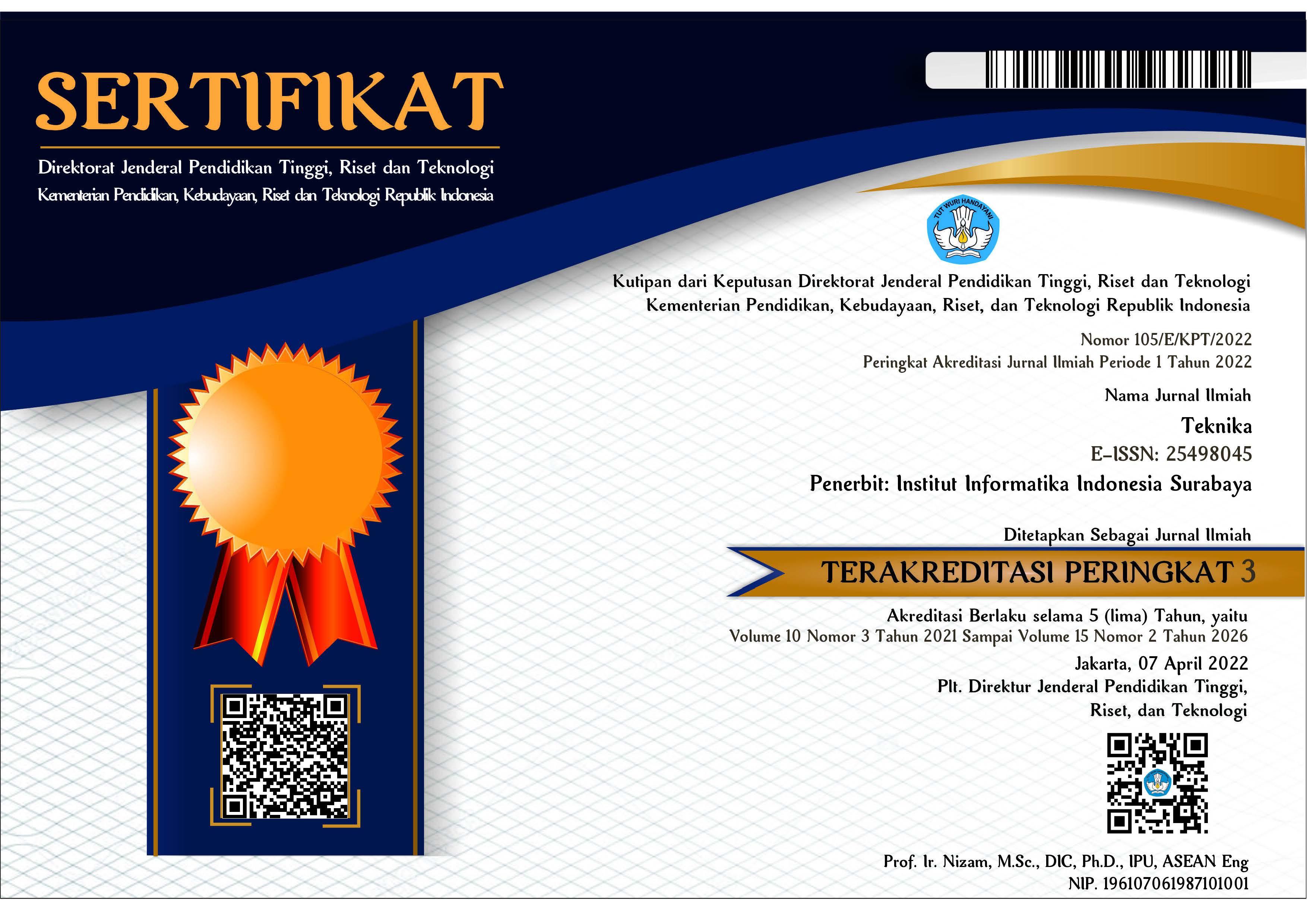Evaluation of Uses and Gratifications on Online Otome Games
DOI:
https://doi.org/10.34148/teknika.v12i2.613Keywords:
UGT, Online, Otome, Games, Tears of ThemisAbstract
In this advanced world of technology, games have become a fun entertainment that is loved by the people. This study aimed examine online otome game, which in this case study is Tears of Themis, using uses and gratification theory-based model that consists of enjoyment, fantasy, escapism, social interaction, social presence, achievement, self-presentation and also age moderation variable which affects the continuance intention to play Tears of Themis. The analysis testing and model development were performed using PLS-SEM method on 135 respondents who were Tears of Themis players from Indonesia. The results revealed that enjoyment and achievement have significantly affected the continuance intention of playing Tears of Themis. Meanwhile, the moderation test results showed no relation between all independent variables and continuance intention. But based on the age sub-groups, 16 — 19 years old subgroup are affected by enjoyment and self — presentation on Tears of Themis continuance intention and 20 — 24 years old subgroup are influenced by enjoyment on Tears of Themis continuance intention. These results can be used as insight for development of online otome games to improve the quality of games in the future.
Downloads
References
D. M. Dahwilani, “Survei: 16,5 Persen Masyarakat Habiskan Waktu Main Game Online selama Pandemi Covid-19,” iNews.id, 2020. https://www.inews.id/techno/internet/survei-165-persen-masyarakat-habiskan-waktu-main-game-online-selama-pandemi-covid-19 (accessed Jun. 19, 2022).
B. A. Pramudita, “Pandemi, Jumlah Mobile Gamer di Indonesia Naik Dua Kali Lipat,” Warta Ekonomi, 2021. https://wartaekonomi.co.id/read347940/pandemi-jumlah-mobile-gamer-di-indonesia-naik-dua-kali-lipat (accessed Jun. 19, 2022).
“The Global State of Digital in April 2023 - We Are Social USA,” We Are Social, 2023. https://wearesocial.com/us/blog/2023/04/the-global-state-of-digital-in-april-2023/ (accessed May 22, 2023).
D. Novianty and D. Prastya, “Game Mobile Kini Kuasai Pasar, Kalahkan Game Konsol dan PC,” suara.com, 2022. https://www.suara.com/tekno/2022/02/06/154440/game-mobile-kini-kuasai-pasar-kalahkan-game-konsol-dan-pc (accessed Jun. 19, 2022).
A. M. Damar, “Mobile Gamer di Indonesia Tumbuh 2 Kali Lipat Selama Pandemi - Tekno Liputan6.com,” liputan6.com, 2021. https://www.liputan6.com/tekno/read/4592979/mobile-gamer-di-indonesia-tumbuh-2-kali-lipat-selama-pandemi (accessed Jun. 20, 2022).
Niko, “Play like a girl: Key ways to engage one of Asia’s fastest growing gaming audiences,” Niko, 2020. https://nikopartners.com/play-like-a-girl-key-ways-to-engage-one-of-asias-fastest-growing-gaming-audiences/ (accessed Sep. 16, 2022).
H. Kim, “Women’s Games in Japan: Gendered Identity and Narrative Construction,” Theory Cult Soc, vol. 26, no. 2—3, pp. 165—188, Mar. 2009, doi: 10.1177/0263276409103132.
J. Lebowitz and C. Klug, Interactive Storytelling for Video Games. Routledge, 2012. doi: 10.4324/9780240817187.
Y. Huan, “Female Representation in Chinese Otome Games: Comparative Research on Three Famous Games from 2017 to 2021,” in Advances in Social Science, Education and Humanities Research, 2022. doi: 10.2991/assehr.k.220131.175.
S. Romano, “miHoYo announces otome ‘romance x detective x adventure’ game Tears of Themis for iOS, Android - Gematsu,” Gematsu, 2021. https://www.gematsu.com/2021/04/mihoyo-announces-otome-romance-x-detective-x-adventure-game-tears-of-themis-for-ios-android (accessed Oct. 23, 2022).
A. Pratnyawan, “Tears of Themis, Game Detektif yang Romantis dari miHoYo Ini Siap Meluncur - HiTekno.com,” hitekno.com, 2021. https://www.hitekno.com/games/2021/07/16/132535/tears-of-themis-game-detektif-yang-romantis-dari-mihoyo-ini-siap-meluncur (accessed Sep. 26, 2022).
H. Li, Y. Liu, X. Xu, J. Heikkilä, and H. van der Heijden, “Modeling hedonic is continuance through the uses and gratifications theory: An empirical study in online games,” Comput Human Behav, vol. 48, pp. 261—272, Jul. 2015, doi: 10.1016/j.chb.2015.01.053.
R. M. Ryan and E. L. Deci, “Intrinsic and Extrinsic Motivations: Classic Definitions and New Directions,” Contemp Educ Psychol, vol. 25, no. 1, pp. 54—67, Jan. 2000, doi: 10.1006/ceps.1999.1020.
J. L. Sherry, B. S. Greenberg, K. Lucas, and K. A. Lachlan, “Video game uses and gratifications as predictors of use and game preferences,” in Playing Video Games: Motives, Responses, and Consequences, P. Vorderer and J. Bryant, Eds., 1st ed.New York: Routledge, 2006, pp. 213—224. doi: 10.4324/9780203873700.
J. A. Ghani and S. P. Deshpande, “Task Characteristics and the Experience of Optimal Flow in Human–Computer Interaction,” J Psychol, vol. 128, no. 4, pp. 381—391, Jul. 1994, doi: 10.1080/00223980.1994.9712742.
F. Biocca, C. Harms, and J. K. Burgoon, “Toward a More Robust Theory and Measure of Social Presence: Review and Suggested Criteria,” Presence: Teleoperators and Virtual Environments, vol. 12, no. 5, pp. 456—480, Oct. 2003, doi: 10.1162/105474603322761270.
N. Yee, “Motivations for Play in Online Games,” CyberPsychology & Behavior, vol. 9, no. 6, pp. 772—775, Dec. 2006, doi: 10.1089/cpb.2006.9.772.
I. Puspitasari, E. O. Syahputra, I. K. Raharjana, and F. Jie, “The Continuance Intention of User’s Engagement in Multiplayer Video Games based on Uses and Gratifications Theory,” Journal of Information Systems Engineering and Business Intelligence, vol. 4, no. 2, p. 131, Oct. 2018, doi: 10.20473/jisebi.4.2.131-138.
S. Bueno, M. D. Gallego, and J. Noyes, “Uses and Gratifications on Augmented Reality Games: An Examination of Pokémon Go,” Applied Sciences, vol. 10, no. 5, p. 1644, Mar. 2020, doi: 10.3390/app10051644.
A. Z. Abbasi, U. Rehman, M. S. Fayyaz, D. H. Ting, M. U. Shah, and R. Fatima, “Using the playful consumption experience model to uncover behavioral intention to play Multiplayer Online Battle Arena (MOBA) games,” Data Technologies and Applications, vol. 56, no. 2, pp. 223—246, Mar. 2022, doi: 10.1108/DTA-02-2021-0055.
H. Mahfuzra, A. N. Hidayanto, I. C. Hapsari, and P. Utari, “What drives the intention to repurchase digital items in digital games An integration of uses and gratifications theory and the expectation-confirmation model,” Int J Bus Inf Syst, vol. 30, no. 3, p. 253, 2019, doi: 10.1504/IJBIS.2019.098245.
Sugiyono, Metode Penelitian Kuantitatif, Kualitatif, dan R&D. Bandung: Alfabeta, 2006.
J. F. Hair, B. J. Babin, R. E. Anderson, and W. C. Black, Multivariate Data Analysis. United Kingdom: Cengage Learning EMEA, 2018. Accessed: Nov. 03, 2022. [Online]. Available: https://books.google.com/books/about/Multivariate_Data_Analysis.html?hl=id&id=0R9ZswEACAAJ
A. Ferdinand, Metode Penelitian Manajemen. Semarang: BP Universitas Diponegoro, 2014.
Sugiyono, Metode Penelitian Kuantitatif, Kualitatif, dan R&D. Bandung: Alfabeta, 2009.
J. F. Hair, W. C. Black, B. J. Babin, and R. E. Anderson, Multivariate Data Analysis, 7th ed. Pearson, 2010. Accessed: Mar. 28, 2023. [Online]. Available: https://books.google.com.my/books/about/Multivariate_Data_Analysis.html?id=JlRaAAAAYAAJ&pgis=1























